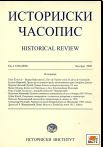Лијевче поље - белешке о насељима и природи 15 - 19. век
Lijevče Polje - Some Notes on the Settlements and Environment, 15th - 19th Century
Author(s): Jelena MrgićSubject(s): History
Published by: Istorijski institut, Beograd
Keywords: Lijevče polje; Bosnia; XV–XIX centuries; environmental changes; settlement history
Summary/Abstract: This article aims to present available data on the changes of environment and settlements that existed in the field of Lijevče, from the 15th until the 19th century. Documentary data, both medieval and Ottoman, are scarce and yield scant evidence. Therefore, we have relied on archeological data and cartographic material. Due to several literary descriptions and travel accounts of Lijevče polje, we have been able to target the beginning of the shaping of presentday landscape. Similar to neighbouring Slavonija, the plain of Lijevče, on the left bank of lower Vrbas river, was densely forested until modern times. Vast forests of oak and beech wood, mixed with poplar and willow trees in flooded areas, represented a very significant natural resource. Settlements, together with the arable land, appeared on the ground of forest clearings, like oases in the “forest desert”. Through the soft, alluvial soil, innumerable water flows interwove, making the imperative that the inhabitants should protect their homes and crops from floods. Therefore, they built primitive system of trenches, ditches and earth dams, which served, on one side, as fishing ponds, and on the other, asdry transportation routes. Because of extensive agriculture and drainage, the whole area of Lijevče, with its numerous archeological sites, went though dramatic changes.During the second half of the century, the town of Levač (Lijevče) emerged from a feudal residence place. Due to the cartographic evidence and archeological material, we are able to finally identify this settlement, which gave its name to the whole plain. It was located some 8 kilometers in the east from Bosanska Gradiška, and only a couple of kilometers from Sava river, in the area of today’s village of Laminci. In the eve of the Ottoman conquest, the name of Lijevče was used as the synonym for the plain of Vrbas (campus Vrbas). The Ottoman authority took it over and named its administrative unit nahiye Lefçe, with 34 villages, 20 mahalas and 9 mezraas. The settlement itself went through changes. The wooden fortress was left to detriment, probably soon after the Ottoman conquest of Slavonija (1540). There are no evidence of this settlement in travel accounts or cartographic material, until its end days. One Russian official report stated that the inhabitants of the village Lijevče had deserted this settlement in 1865, and they had gone to Slavonija, but they had left no trace in the new homeland. Several years later began the new wave of German colonization, which again resulted in the change of the place names and settlement pattern. Full-scale industrialization of agricultural practice happened only after the Second World war, but drainage works were performed much later, during the 70-ties and 80-ties.
Journal: Историјски часопис
- Issue Year: 2007
- Issue No: 55
- Page Range: 171-199
- Page Count: 29
- Language: Serbian

